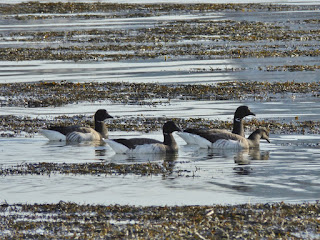I worked a long day on Monday 7th January and then had the rest of the week off as annual leave, ideal after having survived another Christmas and New Year, and with the kids back to school, perfect for getting out to do some New Years birding especially considering the dry and settled weather.
And so Wednesday 9th January kicked things off with a surprise trip to Topsham, unexpected but with David wanting to have a look around the antiques centre and then visit a friend on Dartmoor on the return journey back to Plymouth I wasn't going to turn it down. It was cold and still and sunny when David dropped me off at Bowling Green Marsh and I started off with a quick look from the first viewing screen at Goosemoor where a greenshank was feeding very close in with a redshank as the tide was receding and a water rail gave some nice if shaded views as it fed out in the open before scuttling back into the reeds.
Water Rail, Goosemoor
Onwards to the hide where the water levels on the marsh were very high and shoveler, teal, mallard and tufted duck were all seen along with a female pochard, 2 pairs of gadwall and a pair of pintail plus moorhen, snipe and lapwing.
Pintail, Bowling Green Marsh
Moving on to the viewing platform and in the field by the path were a feeding flock of wigeon and black-tailed godwits (one of which had plastic bling on its legs) and amongst them were 2 greylag geese, snipe, lapwing, teal and a nice ruff. A female bullfinch, a very tame robin and a male blackbird were feeding in the hedgerow and a stock dove flew overhead displaying while a buzzard watched the goings on from a fence post.
Black-tailed Godwit with leg rings
Ruff
Blackbird
Robin
The tide was quite low but from the platform I found 2 grey plover and a few avocets amongst the redshank, dunlin and black-tailed godwits, while from The Goatwalk avocets were more numerous and much closer allowing for better views.
Avocet from The Goatwalk, Topsham
From The Goatwalk a distant flock of around 200 golden plover were roosting on the mudflats along with a large group of brent geese, while from Topsham Quay 2 male and 3 female red-breasted mergansers were seen along with 2 black swans. However it was soon time to meet David for lunch and then head on up to Dartmoor - but not a bad couple of hours birding.
Black Swan, Topsham Quay
Black-headed Gull, Topsham Quay
Black-headed Gull, Topsham Quay
Thursday 10th January and we drove to Burrator Reservoir on Dartmoor for a walk on another cold but still and sunny morning. Mallard, just 1 white farmyard goose, a grey heron, 4 cormorant and a black-headed gull were seen on the reservoir while the woods held good numbers of great tits and blue tits with coal tits, long-tailed tits, goldcrest, jays, nuthatch, a mistle thrush and 2 treecreepers also seen. Overhead 4 ravens were calling noisily while displaying and tumbling.
I could hear siskins calling in the trees and briefly heard a crossbill flying over but finally in the pine trees by Lowery Barn I managed go get some good views of siskins, coal tits and at least 6 crossbills feeding on the pine cones. The crossbills were easy to overlook and I only got on to them when the called, the views were difficult too as they were mostly obscured by branches and were feeding right at the top of the very tall trees but there were at least 3 male and 3 females present with 1 female giving some very good views and flashing off its very yellow rump as it fed on the pine cones.
Friday 11th January and I caught the early bus to Slapton Ley, alighting at Torcross at 9:15am after leaving Plymouth at 7:30am, and it again was cold and still but mostly cloudy with occasional sunny spells.
A Cetti's warbler gave some brief and obscured views in the undergrowth by the tank but 2 female reed buntings were much more showy. I found the male ring-necked duck amongst the tufted ducks but it was near the opposite shore so the views were a little distant but 2 male and 5 female goldeneye, 2 male and a female pochard and a black-backed grebe gave closer views along with coot, gadwall, mallard, great-crested grebe and cormorant.
Black-headed Gulls, Torcross
Goldeneye, Slapton Ley
Out at sea gannets and kittiwakes were feeding with a few coming in close to shore including a smart juvenile kittiwake and auks were buzzing around offshore but too far out to confirm ID. A great northern diver was close to shore while a red-throated diver further out flew off towards Start Point, doing its occassional distinctive head lift as it went.
Lesser Black-backed Gulls
Herring Gull and Lesser Black-backed Gull
I walked along the Ley and then along the path at the back of the Ley to the quarry and after a bit of a wait and a few brief and obscured views a firecrest finally gave itself up and showed very well along with goldcrests, long-tailed tits, a mistle thrush, a jay, 2 chiffchaffs and a male blackcap.
I then met up with David and we enjoyed lunch at The Start Bay Inn at Torcross before heading back to Plymouth - a very successful day out and with my year list now on a nice 100.

















































